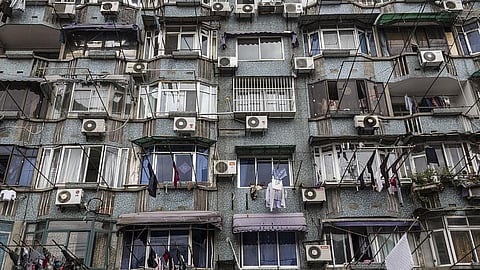
- Topics
- Feature
- Opportunities & Events
- About
- Hindi Portal
- Data
- Topics
- Feature
- Opportunities & Events
- About
- Hindi Portal
- Data

The demand for air conditioning is growing at 10-15% annually in India due to a combination of factors including increasing affluence and rising temperatures due to global warming. The average energy efficiency of air conditioners (AC) sold in Indian markets are among the lowest compared to other emerging and developed economies. They also use refrigerants that have medium to high-Global Warming Potential (GWP).
If India starts enhancing the energy efficiency of ACs at double the current rate (from 3% to 6% annually), and replace medium to high-GWP refrigerants with natural refrigerants, it can reduce cooling energy demand by 40% and greenhouse gas (GHG) emissions by 400 million tonnes/ annum by 2030. This is more GHG abatement than installing 100 GigaWatt (GW) of solar PV plants.
India has huge potential to improve on access and availability of green cooling by:
Using natural refrigerants like hydrocarbons in ACs and shifting to NIK technologies will also give a big boost to Make in India.
The ‘Green Cooling in India’ webinar organised by the International Forum for Environment, Sustainability and Technology (iFOREST), brought together government officials, air-conditioning & refrigeration industry representatives, policy experts and researchers to discuss the opportunities of boosting energy efficient and low-GWP (global warming potential) cooling systems in India. A series of policy briefs Green Cooling was also released at the event.
The inaugural session was attended by Dr Anshu Bharadwaj, CEO, Shakti Sustainable Energy Foundation, Shri Aditya Narayan, Additional Director, Ozone Cell, Ministry of Environment, Forest & Climate Change (MoEF&CC) and Chandra Bhushan, CEO, iFOREST.
Speaking at the event, Aditya Narayan, emphasised on the importance of staying on track with the implementation of the India Cooling Action Plan (ICAP) in order to maximise environmental, developmental and climate benefits while providing sustainable cooling for all. “Synergies in existing government programmes and policies will be crucial for ICAP's successful implementation,” said Mr Narayan.
Dr Anshu Bharadwaj, also emphasized on importance of achieving the goals of the ICAP while considering natural refrigerants as suitable alternatives to high-global warming potential Hydrofluorocarbons (HFCs). He also added that the air conditioning (AC) demand in the residential sector is growing rapidly, and it is the right time for a course correction from high-global warming potential (GWP) refrigerants and inefficient ACs said Dr Bharadwaj.
Presenting the main findings of the research, Chandra Bhushan, CEO of iFOREST said that, “Given the increasing temperature due to global warming, cooling is now a basic developmental need. But if we continue using the current cooling technologies, then it will further exacerbate warming. We need to break this vicious cycle by meeting by ever growing cooling demand through super-efficient appliances, natural refrigerants and not-in-kind cooling technologies.”
The iFOREST research, which was released at the webinar, found the following:
Speaking at the event various panellists also emphasized on implementation aspects of ICAP, promoting natural refrigerants and NIK technologies.
About ICAP’s implementation, Sumedha Malaviya, World Resources Institute (WRI) India emphasized on the role of state governments. Drawing on examples of states, such as Telangana, she said that “It is very important to bring the State Governments on board in this. Otherwise, it will remain a top-down process and implementation will be undermined.”
On NIK technologies, Apurupa Gorthi, researcher at iFOREST stated that “lack of awareness, high cost, difficulty with retrofitting and skeletal manufacturing setup” are some of the barriers for mainstreaming it. Talking about the way to overcome this and promote NIK technologies and natural refrigerants, Tanmay Tathagat, of Environment Design Solutions emphasized that “cost effectiveness will be a key aspect and also having quality standards”. Prasanna Rao Dontula of A.T.E Group also pointed on the need of awareness among industries and stakeholders, to promote these.
The panel discussion on integrating energy efficiency with the refrigerant transition focused on financing this transition. Prima Madan of Natural Resource Defence Council (NRDC) said that “we need tools for facilitating the joint transition of refrigerant and energy efficiency. Recent negotiations at the Montreal Protocol have made a progress on this front. Additional financial mechanism will have a key role to play”.
Concluding the meeting, Chandra Bhushan added that “successful implementation of the ICAP would need three elements: priority list of actions that can be measured and tracked, localisation of ICAP through the involvement of state and city governments and by explicitly incentivising natural refrigerants and NIK”.